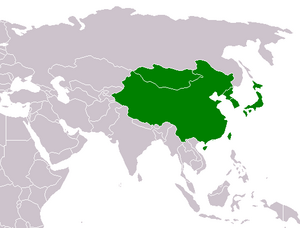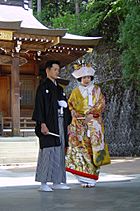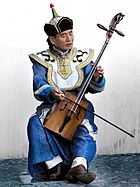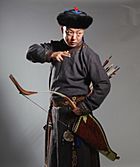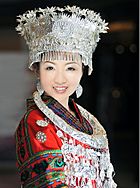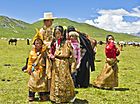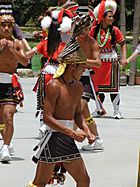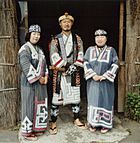East Asia facts for kids
East Asia is a big part of the continent of Asia. It covers about 6.64 million square kilometers, which is about 15% of Asia's total land. This region is home to many different cultures and people.
Here are the main countries and special areas in East Asia:
- People's Republic of China (but not Tibet, which is in South Asia)
- Hong Kong
- Japan
- North Korea
- South Korea
- Macao
- Mongolia
- Republic of China (Taiwan)
Contents
People and Population
East Asia is home to a huge number of people. Many different groups live here, each with their own unique traditions and languages.
Countries and Their Capitals
Here's a quick look at the countries in East Asia, their populations, and capital cities:
| Country/Area | Population (2018) |
Capital City |
|---|---|---|
| 1,427,647,786 | Beijing | |
| 7,371,730 | Hong Kong | |
| 631,636 | Macao | |
| 127,202,192 | Tokyo | |
| 3,170,216 | Ulaanbaatar | |
| 25,549,604 | Pyongyang | |
| 51,171,706 | Seoul | |
| 23,726,460 | Taipei |
Main Ethnic Groups
Many different ethnic groups live in East Asia. Here are some of the largest groups, their populations, and the languages they speak:
| Ethnic Group | Population | Language(s) | Traditional Clothes |
|---|---|---|---|
| Han/Chinese | 1,268,000,000 | Chinese (like Mandarin, Cantonese, Hokkien) | |
| Yamato/Japanese | 125,117,000 | Japanese | |
| Korean | 79,432,225 | Korean | |
| Mongols | 8,942,528 | Mongolian | |
| Uyghurs | 15,000,000+ | Uighur | |
| Manchus | 10,422,873 | Northeastern Mandarin, Manchu language | |
| Hmong/Miao | 9,426,007 | Hmong/Miao, Southwestern Mandarin | |
| Tibetans | 6,500,000 | Tibetan | |
| Indigenous Taiwanese Peoples | 533,600 | Austronesian languages (like Amis, Yami) | |
| Ryukyuan | 1,900,000 | Japanese, Ryukyuan | |
| Ainu | 200,000 | Japanese, Ainu |
East Asian Culture
The culture of East Asia has been greatly shaped by China. For a long time, China was the most powerful and influential civilization in the region. Its ideas, knowledge, and literature became the base for much of East Asian culture.
Things like Confucianism (a way of thinking about life and society), the Chinese calendar, and even how governments were set up, spread from China to places like Japan and Korea. They also shared a common way of writing, which you can see in the history of Japanese and Korean writing.
China's strong economy and culture also led to a system of trade and relationships with its neighbors. This helped different cultures in East Asia share ideas and goods, making the region's history very connected. You can compare China's influence in East Asia to how ancient Greece and Rome influenced Europe and the Western World.
Related pages
Images for kids
-
Different ideas of where Central Asia is, sometimes overlapping with East Asia.
-
Tokyo is the capital of Japan and one of the biggest cities in the world.
-
Seoul is the capital of South Korea and a major center for technology.
-
Shanghai is the largest city in China.
-
Beijing is the capital of the People's Republic of China.
-
Osaka is the second largest city area in Japan.
-
Guangzhou is an important city in southern China with a history of over 2,200 years. It was a major stop on the ancient Silk Road for trade.
-
Kyoto was the capital city of Japan for 1,100 years.
-
Ulaanbaatar is the capital of Mongolia.
-
Hong Kong is a global financial center and a very modern city.
-
Pyongyang is the capital of North Korea, located on the Korean Peninsula.
-
Taipei is the capital and financial center of Taiwan, known for its high-tech industries.
See also
 In Spanish: Asia Oriental para niños
In Spanish: Asia Oriental para niños


